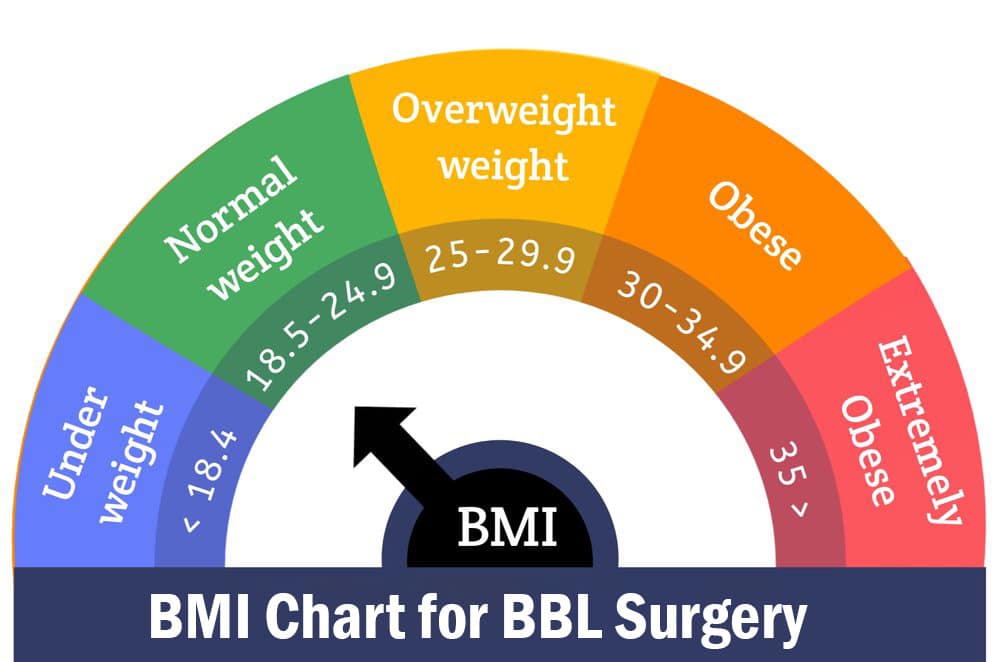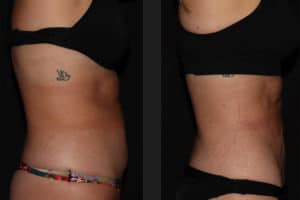*Please enter all fields for an accurate BMI calculation.
BMI Categories:
Underweight = <18.5
Normal weight = 18.5–24.9
Overweight = 25–29.9
Obesity = BMI of 30 or greater
| BMI | Classification | Suitability for BBL |
|---|---|---|
| < 18 | Underweight | Not recommended |
| 18-24 | Healthy | Good candidate |
| 25-29 | Overweight | Good candidate |
| 30-35 | Obese I | Careful assessment needed |
| 35-40 | Obese II | Not recommended |
| > 40 | Obese III | Not recommended |
Unlock Your Perfect Curves with 10% off Skinny BBL in Miami
One of the hallmarks of beauty is a large and shapely rear end for many people. A growing number of women are turning to cosmetic surgery to enhance this part of their bodies, leading to the phenomenal popularity of the Brazilian Butt Lift (BBL).
Unfortunately, not everyone who wants to undergo a BBL procedure qualifies for one. There are a few boxes to check before undergoing a BBL. One of them has to do with Body Mass Index (BMI). If you are looking for a BBL in Miami, you can contact us.
What is a BMI?
BMI stands for Body Mass Index. It is a way of determining if you are currently at a healthy weight. The BMI is a number that is not calculated by weight alone. Instead, it also takes into account your height. For example, a person weighing 150 lbs. may have a healthy BMI if they are 5’10”, while someone of the same weight, only 5’5″, maybe considered unhealthy.
If you have a higher BMI, you are at a greater risk of developing health problems like heart disease, cancer, and diabetes. In cosmetic surgery, having a higher BMI means you have a greater risk of surgical complications.
BMI ranges and what they mean (applies to both men and women):
- Underweight: BMI under 18.5
- Healthy weight: 18.5 to 24.9
- Overweight: 25 to 29.9
- Obese: 30 or higher
Your plastic surgeon can determine your BMI for you during your consultation. Or, if you prefer to do that online, search for “BMI calculator online” and enter your height and weight into the website’s online calculator, which will tell you your individual Body Mass Index.
What is a good BMI for a BBL?
There are no exact rules for what makes a good BMI for a given patient, as each plastic surgeon tends to have a somewhat different philosophy. However, here are some rough guidelines to what qualifies as a good BMI for a BBL:
Under 35
If your BMI is under 35, and you have no other serious medical problems, you will likely make a reasonable candidate for a BBL. The presence of any comorbidities can definitely affect your decision to have an elective procedure.
35 to 40
If your BMI falls within this range, your plastic surgeon will determine your procedure’s suitability based on your current health profile. If you have no relevant medical conditions, they may clear you for surgery, although they may ask you to lose weight first.
Over 40
If your BMI is over 40, you’ll almost certainly not make a good candidate for a BBL procedure. Most plastic surgeons would find the risk of surgical complications too great.
Can You Get a BBL with a high BMI?
What qualifies as “too high” of a BMI for a BBL is a somewhat subjective matter that is normally left up to each individual surgeon and patient, as there is no consensus on this definition. However, an ethical surgeon will err on the side of caution.
Reducing Your BMI
If your plastic surgeon informs you that your BMI is too high to qualify for a BBL, you should instead focus on losing weight and enhancing your general health by dieting and exercising. The procedure will still be available when you are ready.
What is the minimum weight to get a BBL?
In terms of weight, the most important factors are Body Mass Index and whether the patient has enough fat present for liposuction. For example, two patients of the same height and weight may have fat distributed differently on their bodies. However, underweight people tend to have less fat available for donation, making them less likely to qualify for a BBL.
BMI Assessment
As mentioned earlier, your BMI plays an essential part in determining your level of complication risk after your BBL procedure. The higher your BMI, the greater your risk of experiencing problems with your surgery.
Since cosmetic surgery is an optional procedure, you want to limit your surgical risks as much as possible. BMI is a controllable risk that you can bring into an acceptable range before undergoing a BBL procedure. When your BMI is over 35, your risk of surgical complications is increased.
What is a BBL?
The BBL is a cosmetic surgery that involves a liposuction procedure on one part of the body, followed by the addition of this donated fat into the buttocks to enhance fullness and contours.
BBL procedures differ from other types of buttocks augmentation in that no implants are involved in the procedure. Instead, fat taken from the patient’s own body is used to enhance the area’s appearance.
BBL Consultation
The best way to determine if you qualify for a BBL procedure is to schedule a consultation with your preferred plastic surgeon. Find someone who is board-certified – a must! – and experienced in performing BBL procedures. It helps to look at patient before-and-after photos that you can typically find on your surgeon’s website.
Before meeting with your plastic surgeon at the initial consultation, write down your questions and concerns. This will help ensure that you don’t forget anything during this critical meeting.
Some things your plastic surgeon will want to know about during your consultation include:
- Your treatment goals and expectations
- Your medical history, including any surgeries
- Any medications you’re taking, including supplements
- Your current weight and Body Mass Index (BMI)
After gathering all the needed information, your plastic surgeon will work with you to develop an individualized procedure plan just for you and your unique situation.
The BBL Procedure
A Brazilian Butt Lift procedure usually takes place under general anesthesia, ensuring that you are asleep and experience no pain. Your surgeon will form tiny incisions and insert a tube called a cannula into them to remove fat from the donor area, which is then transferred into a sterile container.
Next, your surgeon will connect another cannula onto the container, transferring the contained fat into your buttocks area to enhance shape and volume. They will then close your incisions with sutures, place compression garments, and send you home to recover.
Ideal BMI for BBL: Understanding What You Need to Know Before Your Butt Augmentation
The ideal Body Mass Index (BMI) for a Brazilian Butt Lift (BBL) procedure is generally considered to be between 18 and 30. This range is considered optimal because it allows for enough fat to be harvested from other areas of the body to be used for the BBL, while also ensuring that the patient is healthy enough for the procedure. However, BMI is not the only criteria considered for a BBL, the surgeon will evaluate the patient’s overall health, skin tone and elasticity, the amount and quality of fat available, and the patient’s aesthetic goals to determine if they are a good candidate for the procedure.
BMI Requirements for BBL
The ideal Body Mass Index (BMI) for a Brazilian Butt Lift (BBL) procedure is generally considered to be between 18 and 30. This range is considered optimal because it allows for enough fat to be harvested from other areas of the body to be used for the BBL, while also ensuring that the patient is healthy enough for the procedure.
However, BMI is not the only criteria considered for a BBL, the surgeon will evaluate the patient’s overall health, skin tone and elasticity, the amount and quality of fat available, and the patient’s aesthetic goals to determine if they are a good candidate for the procedure.
What is the Minimum BMI Requirement for a Brazilian Butt Lift (BBL) Procedure?
The minimum body mass index (BMI) for a Brazilian Butt Lift (BBL) procedure is typically around 18-20, but this can vary depending on the surgeon and the patient’s overall health and body composition. It’s important to have a consultation with a qualified plastic surgeon to determine if a BBL is appropriate for you.







